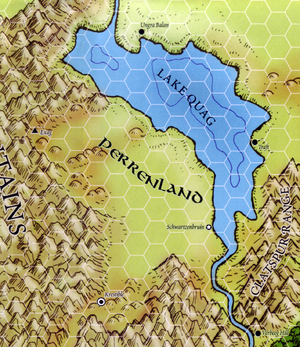Difference between revisions of "Rise of the Runelords"
m (template rder) |
m (→Characters: rare races expanded) |
||
| Line 15: | Line 15: | ||
'''Common Races''': | '''Common Races''': | ||
| − | Dwarves, | + | '''Dwarves''', |
| − | Eladrin (there is a neary Eladrin kingdom), | + | '''Eladrin''' (there is a neary Eladrin kingdom), |
| − | Humans (Common, Minor, Flan, and Oerdian). | + | [[Humans (Greyhawk 4E)|Humans]] (Common, Minor, Flan, and Oerdian). |
'''Rare Races:''' | '''Rare Races:''' | ||
| − | Thieflings ( | + | '''Thieflings''', Humans ([[Olman (Greyhawk 4E)|Olman]] or [[Foreigners (Greyhawk 4E)#Foreigners|foreigeneers]]). These will attract attention and possibly ire. |
==Perrenland== | ==Perrenland== | ||
Revision as of 11:43, 13 November 2008
 |
| 4th Edition Dungeons & Dragons |
Error: Image is invalid or non-existent. |
Planned to start in Perrenland in the North-West part of central Greyhawk, Rise of the Runelords is expected to be a quick-leveling heroic campaign.
Characters
Characters are built on 25 points or by a semi-random method.
- Roll a set of nine attribute scores. For each score, roll 4d6 and discard the lowest.
- You have 20 points to spend. Decide which of the rolled attributes you want to use, and which you want to discard. For each of the rolled attributes that you keep, you get one extra attribute point to spend. This results in characters built on 20 to 26 ability points.
- Spend any remaining points until you have 6 attribute scores in total.
- At any time, you can do a 25-point buy instead of taking the rolls.
Humans, Halflings, and Half-Elves have variant rules. Dragonborn are not in play. Gnomes are in play.
Common Races: Dwarves, Eladrin (there is a neary Eladrin kingdom), Humans (Common, Minor, Flan, and Oerdian).
Rare Races: Thieflings, Humans (Olman or foreigeneers). These will attract attention and possibly ire.
Perrenland
Perrenland is a small republic at a crossroads between three cultures; the Oerdians in Nyrond, the Baklunish to the north and west, and the nonhuman empire of Iuz to the east. With a history of fierce resistance to invaders, the Perrin first resisted Oerdian nobles, then the armies of Igliw the witch-queen. Independent since a long time now, the recent Greyhawk Wars saw Perrenland neutral, but sending mercenaries to the enemies of Iuz.
People
A cosmopolitan nation where nationalities and races mix freely, Perrenland is very much a part of the common trade culture centered in Greyhawk city. Trade flows three ways; down the river towards Nyr Dyv and Greyhawk, to the south east Baklunish, and to Wold Nomad markets on the north shore of Lake Quag.
The common tongue is universally recognized as the language of diplomacy and commerce. Still, different groups speak different languages and have different cultures. The language and people can vary wildly from one valley to the next. Oerdians, Flan, Baklunish, and even Suel groups lead their separate lives in remote valleys, along with dwarves, gnomes, and halflings as well as small tribes of humanoids. Rhenne have started appearing outside Perren cities in the last century, and are made welcome because they are clearly not invaders. Overall, the Perenn are friendly towards outsiders as long as they come in small groups not bend on conquest.
Religion
Like most common culture countries, the churches of Perrenland have few mythological ties to each other, being rather a pragmatic collection of gods with useful domains. Animism is also widespread, and worship of spirits and fey is respected under the auspices of Beory, except perhaps by the most devout Cuthbertians.
Pelor: The sun is universally honored, and no less so in Perrenland. The church is cosmopolitan, which makes it suspect in the eyes of some Perrin, but the benefits it brings are hard to argue with.
St. Cuthbert: According to Perrin myth, the saint himself was here and preached; some say the majority of his exploits happened in Perrenland, while others point out that his values are so obviously Perrin that he would not have had to bash so many heads had he been from here. Either way, the church is fiercely independent from other churches of St. Cuthbert and stands as a beacon for Perrin independence. St. Cuthbert is an exarch of Moradin.
Beory: The worship of the great mother is still widespread in the remote parts of the country, tough her claim to supremacy is not recognized. She is seen as the all-mother and the center of life, but is quite a distant goddess. In many cases, those claiming to worship her are actually spirit- or ancestor-worshipers.
Allitur: The Flan god of propriety and peaceful dealings, Allitur embodies the nation's need for unity against outside enemies, cooperation, and peace. He is the official protector of the cantonal council. Allitur is an avatar of Yondalla.
Berei: The first mortal queen among the Flan, Berei is known as the bride of the wilds, the mother of the Flan (and by extension all humans), and the bringer of riches from nature. Her cult embraces the worship of her husband, Obad-Hai as the first king and great hunter. She is an exarch of Beory.
Ulaa: As the goddess of riches found in hills and mountains, Ulaa is popular with miners, prospectors, and dwarves, but also with the many mountain farmers and herdsmen. She is an avatar of Beory.
Zilchus: An invading Oerdian god, Zilchus is well-regarded because he brings wealth trough trade and crafts. Popular in the lowlands and cities. Zilchus is an exarch of Yondalla.
